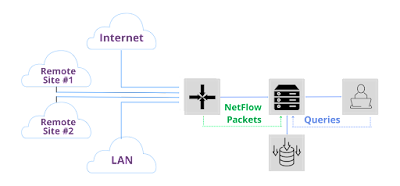In this article, we will explore the world of network analytics, what is network analytics, how it works, how does network analytics collect data, the scrutiny process of network analytics and what problems network analytics solves. We will also look at how network analytics can help us with an example.
Table Of Contents
- What is Network Analytics
- What problems do network analytics solve?
- How does Network Analytics Work?
- How does network analytics collect data?
- Data Collection using NetFlow
- The Scrutiny Process of Network Analytics
- How can Network Analytics Help- An Example
- Conclusion
What is Network Analytics
In a nutshell, network analytics is the process of collecting data about a network in order to scrutinize it for patterns and trends. By doing so, network analysts can solve a variety of problems, from improving network performance to detecting security threats. Applying big data tools and ideas to the information used to manage and safeguard data networks is known as network analytics.
Network analytics refers to any procedure where network data is gathered and examined in order to enhance the network's efficiency, dependability, visibility, or security.
Network analytics can reveal which devices are connected to the network and how they are interacting. A network analytics system should have the ability to compare and correlate network data with data from other devices in addition to being able to ingest various forms of network data (such as NetFlow, syslogs, vendor-proprietary information, etc.).
What problems do network analytics solve?
Prediction
Network managers often evaluate usage patterns to forecast their requirements for hardware, bandwidth, and other services. Here Network Analytics help a lot to predict.
Automated security
To remove or detect known security exploits, viruses, or malware, real-time data packet scanning using AI and ML is required. Automated security will block the bad users and be able to detect and isolate them without the need for human involvement if a bad IP consistently sends malicious requests to a network. The most common applications of network analytics are security scanner and automated anti-virus. Network analytics is widely used for automated security scanning and anti-virus detection.
Diagnostics
System managers must diagnose each issue to fix or resolve it anytime a problem arises as a result of jamming, poor user behavior, security risks, or device failure. A health check feature in network analytics enables the administrator to start a data center operating diagnosis. With application-centric architecture, administrators use network diagnostics to view concurrently operating application processes. Routing and hub appliances are used by administrators to enhance data transmissions for particular software, gadgets, or users on network-based IP addresses.
Resource allocation:
Complex associations make use of network analytics to enable managers to forecast the quantities of switches, routers, hubs, and bandwidth that will be required for regular business operations or industrial facilities.
Administrators can get a summary of historical or current activity on cloud architecture using network analytics.
How does Network Analytics Work?
The data gathered from numerous sources is analyzed and insights are extracted using a software engine in network analytics. These sources include of traffic-flow information (wireless congestion, data speeds, latency, etc.), servers (such as syslog, DHCP, AAA, switches, routers, and wireless), and network equipment (such as switches, routers, and wireless).
Automation of network analytics procedures enables a more thorough examination than was previously achievable using a manual method. The purpose of network analytics is to improve overall user experience without significantly raising operating expenses by scaling to handle additional devices, clients, users, and applications.
Artificial intelligence (AI) and machine learning (ML) technologies are being used by more advanced network analytics systems to enhance the insights they provide.
How does network analytics collect data?
Multiple methods are used in network analytics to get data.
Data Packets
One way is through the use of data packets. Data packets are small pieces of information that are sent between computers on a network. Network analytics software can take these data packets and use them to create a picture of what is happening on the network.
Log Files
Another way that network analytics collects data is through the use of log files. Log files are created by devices on a network and contain information about what has happened on the device. Log files are typically used for troubleshooting or as an audit trail.
SNMP
SNMP is still another method used by network analytics to get data. Simple Network Management Protocol is what the name SNMP stands for. By requesting the status and current settings of network devices using an SNMP collection tool, network analytics gathers data about those devices.
If a problem with one of the devices is detected, then network analytics will let you know which device needs attention. You can also receive notifications when particular events happen such as unauthorized login attempts, when someone unplugs a server from its power source, or when there's no activity for awhile.
Sniffing Traffic
In addition to using data packets, log files and SNMP tools to collect data, network analytics can also collect information by sniffing traffic. This means that network analytics can read every packet of information that travels across a network at a given time. If a device on your network misbehaves in some way, then you will likely see an entry in your logs or other records indicating that something went wrong. Sniffing traffic is one of those more intrusive ways of collecting data from your devices. For this reason, it should only be done if you suspect something bad is going on.
Port Mirroring
Another way that network analytics collects data is by using a utility called port mirroring. Port mirroring allows you to plug your switch into a mirrored port on your network analytics device. This causes all of your switch’s traffic to go through your network analytics device so that you can monitor everything going through your switches at any given time.
Analyzing
In addition to collecting data, network analytics also does what we call analyzing. Analyzing is just what it sounds like – analyzing collected data and generating reports based on what was found. Reports can give you valuable insights into how your network is performing, potential security threats that need to be addressed, user behavior patterns on the network (i.e., who’s downloading illegal content?), where bandwidth congestion may exist within your environment, etc.
Data Collection using NetFlow
NetFlow is a data collection protocol that network devices can use to export information about network traffic flows. This information can be used to scrutinize collected data and solve problems related to network performance and security. With Network analytics there are many ways to get more insight into what's happening on your network by analyzing which users are active on which machines at what time of day and week. Network analytics tools can tell you where the bottlenecks are in your IT infrastructure, who is making changes without permission, and if there has been any malware detected in the last 24 hours.
The Scrutiny Process of Network Analytics
In order to solve problems, network analytics scrutinize collected data. This process helps to understand how different use cases of network analytics can be applied in order to better assess which areas need improvement. Network analytics also play a role in predicting future trends and behaviours.
Network analytics gathers data from hosts, devices, and the network to gain insights. Network analytics may correlate information from various sources and look at problems from various perspectives to create a comprehensive, multidimensional picture of the state of the network as a whole and of its endpoints.
Network Analytics scrutinizes data by the following ways:
Analytics engine
The software program known as the analytics engine gathers data from all around the network and conducts the required analysis. This kind of data analytics may make a comparison between the present situation and a model of ideal performance. Every time the program detects a departure from ideal, it may recommend corrective actions, or it may transmit its results to a higher-level program or the IT team.
Cloud versus local analytics
Networking engineers sometimes argue over whether network analytics should be carried out locally, on the client site, or remotely, in the cloud.
The analytics engine can access significantly more processing power, scale, and network connection by being hosted in the cloud. Modern algorithms and data gathered from the public are also advantages of cloud-hosted analytics. Better insights and remediation performance are provided by installing the analytics engine on-premises, and the volume of data that needs to be backhaulped to the cloud is decreased. These two benefits are especially significant in networks used by larger businesses.
Which is better, local or cloud analytics? The response is "both" Modules for machine learning (ML) and machine reasoning (MR) can be hosted in the cloud to take use of more computer power. However, having the analytics engine on-site can result in significant performance improvements and WAN cost savings.
Correlation
Before providing insights or corrective action, the analytics engine takes the network's interaction between variables into account. Since devices, programs, and services are related to one another, fixing one issue could make other issues worse. Although correlation significantly increases the number of variables in the decision tree and complicates the system, it is necessary so that all factors may be assessed for reliable decisions.
Decision trees
The majority of analytics engines use decision trees to provide advice on performance enhancement. The decision tree determines the appropriate network-device adjustment or reconfiguration to boost performance of that parameter when an analytics engine receives network data showing inadequate performance.
The decision tree expands in accordance with the quantity of streaming telemetry sources and performance-enhancing alternatives available at each node. Analytics was traditionally restricted to supercomputers due to the difficulty of analyzing these enormous data quantities in real time.
Insight
By comparing the incoming streaming telemetry with a model of optimal network performance for each data source, the analytics engine detects network anomalies, malfunctions, and performance degradations. By doing so, new information on how to enhance user experience and network performance is produced.
How can Network Analytics Help- An Example
Network Analytics can be used in many ways. One of the most popular use cases for network analytics is fraud detection. Fraudulent transactions are very difficult to detect because the perpetrators create fake identities with falsified documents which make them difficult to track down. The only way to find these people is by going through huge volumes of data. Network analytics makes this process much easier by identifying patterns that point towards a fraudulent transaction. The algorithm has also been designed to work quickly so that every instance doesn’t have to be analyzed individually as well as increasing accuracy so that false positives don’t happen often. In short, network analytics helps identify what could potentially cause problems in the future and act on those problems now. For example, a company might want to prevent their customers from leaving. Using network analytics they would be able to pinpoint where their customers were coming from and what was causing them to leave so they could address the problem before it became too big. Network analytics will not just prevent potential issues but will also solve them efficiently . Companies will no longer need to spend hours and hours trying to understand what caused a problem when they can just look at their data. With tools like Splunk, companies will be able to analyze all the information they have at their fingertips without having to spend time sorting through different datasets themselves. They will be able to focus more on solving problems rather than understanding what caused them in the first place. If a company knows what the solution is then they can take care of it right away instead of spending countless hours looking for one solution. Not only does network analytics save time but it saves money as well. Before any solutions are put into place, organizations have to perform risk analysis and conduct cost-benefit analyses to determine if the investment will pay off in the long run. These types of analyses require a lot of manpower, resources and man power which means they come with a hefty price tag attached to them. Networks that don’t have the same resources available to them will end up paying even more because they won’t be able to do things like network analytics. That is why organizations must think about what they want out of network analytics and how it solves their problems before making any decisions or investing in anything else.
There are many different uses cases for network analytics including but not limited to detecting intrusions, finding bandwidth hogs, optimizing bandwidth usage, checking up on switches and more. No matter what type of organization you are working for, you should invest in network analytics because it solves problems efficiently while also saving your company money. Network Analytics in many ways help businesses to grow.
Conclusion
In conclusion, network analytics is a process of analyzing data collected from a network in order to solve problems and improve performance. Network analytics can benefit individuals and organizations by helping them to better understand their networks, identify issues and optimize their use of resources. Network analytics, also known as internet analytics or network intelligence, are services that monitor the way that traffic flows through the internet. This can change the shape of an organization or someone's life dramatically.


.png)



0 Comments